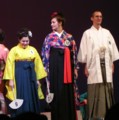|
1. - "It all began like this" – because this picture was taken on the first lesson, when Kinoshita sensei has yet to put the clothes on most of us. This was my first close personal experience with the summer kimono, which is known as, "yukata" in Japanese. In the picture are Kinoshita sensei and three of my kind group members in beautiful dresses. |
2. - "Ryōte ni hana" – this Japanese phrase is used when there are beautiful ladies on both the left and right sides of a man. This picture was also taken at one of the first few lessons. The kimono which I’m wearing on this picture became an integral part of my life for months from then on. |
|
3. - In the company of four famous kimono senseis. My masters: Kinoshita sensei (lower left) and Yamamoto san (above left). Outside of the strict rehearsals, the master invited us for a common lunch or dinner sometimes. |
|
|
5. - Kinoshita sensei, the "severe master", and Yamamoto san, "the kind assistant". I owe it to them for my success at the kimono competition. |
6. - The kimono competition finals took place in Tokyo. As the shinkanzen (high-speed rail) is very expensive, my teachers sponsored my train tickets.
|
|
7. - Noshibukuro. They handed over the donation in this signed envelope. Thank you! :) |
|
|
9. - on the stage during the competition |
10. - on the stage during the competition. The competition is based on timing, that means it takes into consideration how fast you can dress. However, this is not the deciding factor. What is important is the outcome -- that every binding is accurate, every bow and line is in place and there aren’t any unnecessary wrinkles, etc. |
|
11. - The participants from the international category |
12. - A group of Japanese ladies in beautiful kimono |
|
13.
- Group photo of
all the participants in the competition. |
14. - This is a group photo on the cover of the DVD, which was taken by the Japanese television company on the stage of NHK |
|
|
16. - The certificate for the regional round |
|
17. - The certificate for participating in the finals in Tokyo |
18. - I wrote this article for the school newspaper after the regional round and before the finals |
|
19. - This Japanese language video was filmed at the rehearsal hall of Kinoshita sensei. It shows the method to put on the kimono and the accompanying obi correctly. The video was filmed by Peter san. |
20. - This Hungarian video captured our common practise with Peter san as we tried to bind the obi. Taking into consideration the language, it is by no means professional. But although the result is not perfect, some elements are instructive without a doubt. |
|
21. - This video was made at the finals in 2008 in Tokyo. You can see the international group putting on the kimono in this video. |
|

















